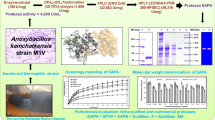Abstract
An extracellular protease isolated fromBacillus subtilis AG-1 was investigated with respect to various detergents and formulation components. The enzyme had optimum at pH 8.0 and 60 °C temperature while zymographic study revealed two activity bands of 24.9 and 18 kDa. It showed high stability towards non-ionic (Tween 20, Tween 80, Triton X-100) and anionic surfactants sodium dodycyl sulfate (SDS), retaining 100 and 71% of its original activity. Another distinctive feature of the enzyme was its efficient stability towards hydrogen peroxide (H2O2) and sodium perborate and different commercial detergent brands. AG-1 protease was also examined for its activity/performance in combination with different stabilizers like glycerol, propylene glycol and polyethylene glycol (PEG). Enzyme showed a promising activity in the presence of this polyols especially PEG (8000). Whilst its compatibility with different commercially available powder and liquid detergents was also very interesting. These results suggest AG-1 protease as a good detergent compatible and can be utilized in the formulation of an environment friendly bio-detergent.
Similar content being viewed by others
References
Ali H.N., Agrebi R., Ghorbel B., Sellami-Kamoun A., Kanoun S., Nasri M. (2007). Biochemical and molecular characterization of a detergent stable alkaline serine-protease from a newly isolatedBacillus licheniformis NH1.Enzyme. Microb. Technol., 40: 515–523.
Bayoudh A., Gharsallah N., Chamkha M., Dhouib A., Ammar S., Nasri M. (2000). Purification and characterization of an alkaline protease fromPseudomonas aeruginosa MN1. J. Ind. Microbiol. Biotechnol., 24: 291–295.
Beg Q.K., Gupta R. (2003). Purification and characterization of an oxidation stable, thiol-dependent serine alkaline protease fromBacillus mojavensis. Enzyme Microb. Technol., 32: 294–304.
Christiansen T., Nielsen J. (2002). Production of extracellular protease and glucose uptake inBacillus clausii in steady-state transient continuous cultures. J. Biotechnol., 97: 265–273.
Ghorbel B., Sellami-Kamoun A., Nasri M. (2003). Stability studies of protease fromBacillus cereus BG1. Enzyme Microb. Technol., 32: 513–518.
Gupta R., Beg Q.K., Lorenz P. (2002a). Bacterial alkaline proteases: molecular approaches and industrial applications. Appl. Microbiol. Biotechnol., 59: 15–32.
Gupta R., Beg Q.K., Khan S., Chauhan B. (2002b). An overview on fermentation, downstream processing and properties of microbial alkaline proteases. Appl. Microbiol. Biotechnol., 60: 381–395.
Kumar C.G., Takagi H. (1999). Microbial alkaline proteases: From a bioindustrial viewpoint. Biotechnol. Adv., 17: 561–594.
Kunitz M. (1947). Crystalline soybean trypsin inhibitor. Part II. General properties. J. Gen. Physiol., 30: 291–301.
Laemmli U.K. (1970). Cleavage of structural proteins during the assembly of the head of bacteriophage T4. Nature, 227: 680–685.
Nasri M., Kamoun A.S., Haddar A., Ali N.H., Frikha B.G., Kanoun S. (2006). Stability of thermostable alkaline protease fromBacillus licheniformis RP1 in commercial solid laundry detergent formulations. Microbiol. Res., 163 (3): 299–306.
Nilegaonkar S.S., Zambare V.P., Kanekar P.P., Dhakephalkar P.K., Sarnaik S.S. (2007). Production and partial characterization of dehairing protease fromBacillus cereus MCM-326. Bioresource Technol., 98: 1238–1245.
Nogueira E., Beshay U., Moreira A. (2006). Characteristics of alkaline protease enzyme produced byTeredinobactor turnirae and its potential applications as a detergent additive. Deutsche Lebensmittel-Rundschau, 102: 205–210.
Schmidt T.M., Bleakley B., Nealson K.H. (1988). Characterization of an extracellular protease from the insect pathogenXenorhabdus luminescens. Appl. Environ. Microbiol., 54: 2793–2797.
Singh J., Batra N., Sobti R. C. (2001). Serine alkaline protease from a newly isolatedBacillus sp. SSR1. Process Biochem., 36: 781–785.
Wikstrom M.B., Elwing H., Linde A. (1981). Determination of proteolytic activity: a sensitive and simple assay utilizing substrates adsorbed to a plastic surface and radial diffusion in gel. Anal. Biochem., 118: 240–246.
Author information
Authors and Affiliations
Corresponding author
Rights and permissions
About this article
Cite this article
Ghafoor, A., Hasnain, S. Characteristics of an extracellular protease isolated fromBacillus subtilis AG-1 and its performance in relation to detergent components. Ann. Microbiol. 59, 559–563 (2009). https://doi.org/10.1007/BF03175146
Received:
Accepted:
Issue Date:
DOI: https://doi.org/10.1007/BF03175146




